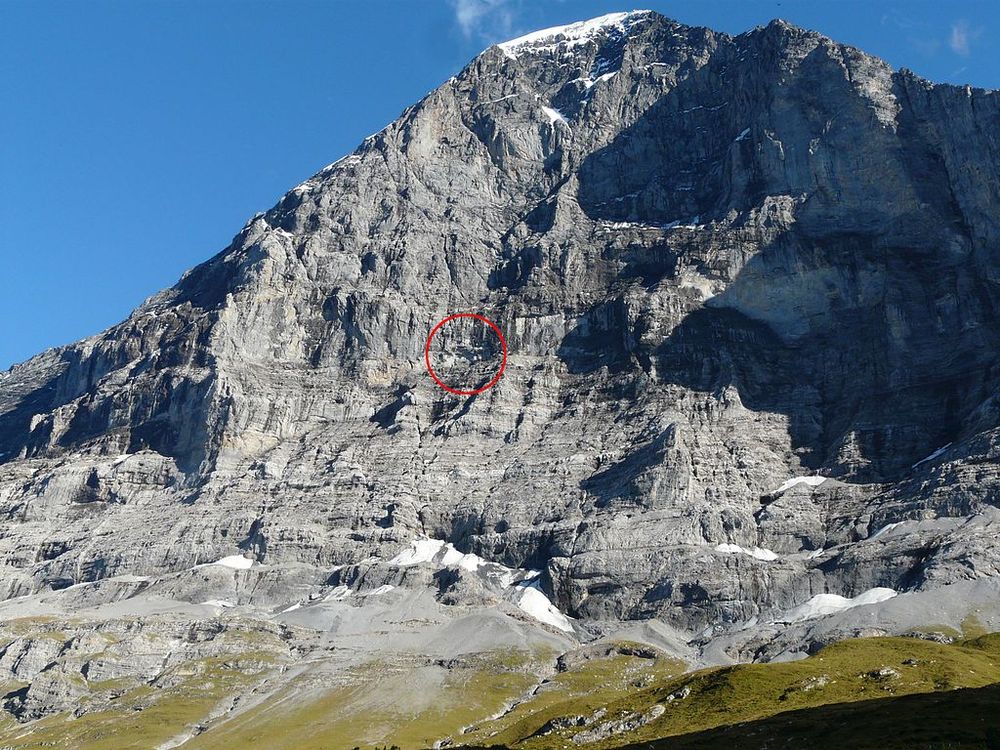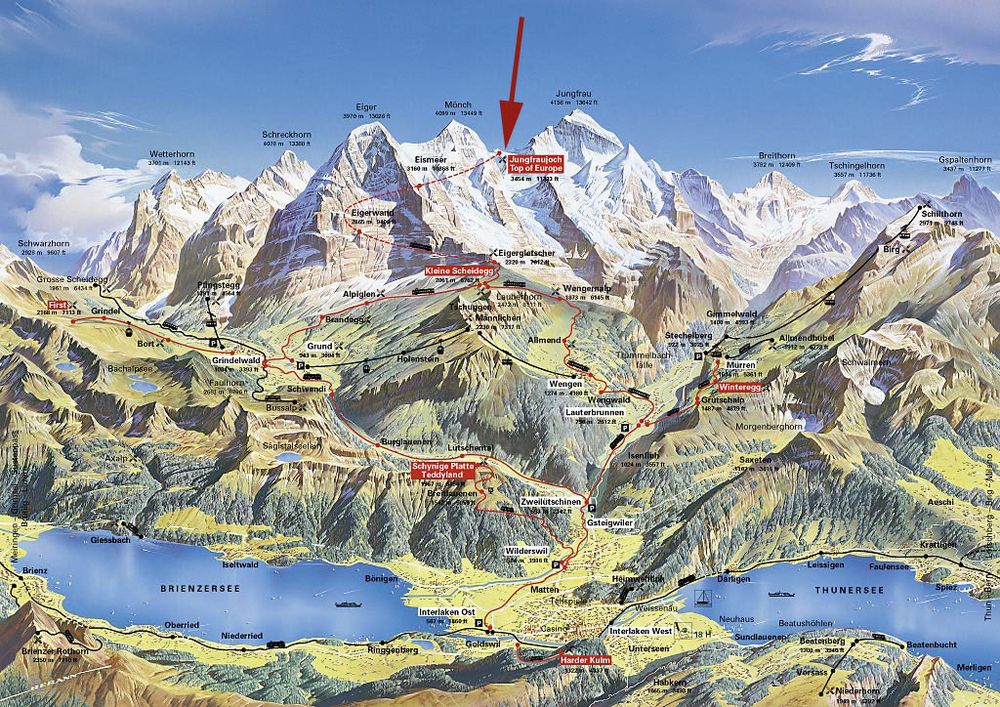The Jungfrau massif is flanked by the Grindelwald and Rhône river valleys in the south-central Swiss Alps, between the towns of Brig and Interlaken. Its main peaks are the Jungfrau itself (in German, the maiden ), which reaches 4,158 meters in altitude, the Mönch (the monk ) with 4,099 meters and the Eiger (the ogre ), with 3,970.
Precisely the latter, the Eiger, is famous for its mythical north face, a vertical wall of 1,500 meters whose extreme difficulty is legendary in mountaineering. More than 60 climbers have lost their lives there on their ascent, since the first attempt in 1934.

The windows of the Eigerwand station on the north wall of the Eiger. Photo: Whgler/Wikimedia
The first time that an expedition completed the ascent of that north face was in 1938. Interestingly, by then there had been a train station carved into the rock of that same wall for more than 30 years, the Eigerwand station.
It is part of the Jungfrau railway (the Jungfraubahn ) whose works began in 1896. It is the highest railway in Europe as it culminates in the highest station on the continent, Jungfraujoch (located between the tops of the Jungfrau and the Mönch), which is located at an altitude of 3,454 meters and was inaugurated on August 1, 1912.
The railway runs for about 9 kilometers connecting Kleine Scheidegg (at an altitude of 2,061 meters) with Jungfraujoch, and runs almost for the most part through a tunnel dug inside the Mönch and the Eiger, in order to protect the line from weather conditions extreme.
In addition to the departure and arrival stations, the railway has two other intermediate stations inside the tunnel. The first is the Eigerwand station, in the section of the tunnel that runs through the interior of the north face of the Eiger, located at an altitude of 2,865 metres.

The red circle marks the position of Eigerwand. Photo: W like wiki/Wikimedia
Until 2016, when the train stopped stopping there, passengers could get off to lean out of the rock-cut windows and gaze at the neighboring mountains (and, who knows, maybe see a climber pass by) for about 5 minutes.
From the Eigerwand station the tunnel bends to the south side of the Eiger and reaches the Eismeer station, which is at 3,160 meters above sea level and gives access to the east face of the mountain with views of the Eismeer or sea of ice . The Eigerwand station opened on June 28, 1903, and the Eismeer station on July 25, 1905.
In addition to a waiting room and a restaurant, the Eismeer station had rooms for tourists at the time of its opening, since at that time, while the line was ending, it was the end of the line. A short flight of stairs provides access from it to the Grindelwald-Fiescher glacier.

The Jungfrau massif with the railway line and the stations Eigerwand, Eismeer and Jungfraujoch. Photo: HFSJG
The only access to the Eigerwand station that is not via the train is a wooden door in the rock face of the mountain. This is the Stollenloch, a hole that was created during the construction of the railway to remove stone and earth while the workers tunneled into the mountain towards the Jungfraujoch.
The Stollenloch has been used on occasions to try to rescue climbers stranded on the mountain, sometimes without positive results, as was the sad case of the German-Austrian expedition of 1936.
The Jungfrau Railway is considered a technical feat of engineering at the end of the 19th century, built with virtually no machines, just picks, shovels and muscle power.
However, the project could not be completed, since the construction of an internal elevator and spiral stairs were also planned to reach the top of the Jungfrau, which never materialized.

The Eigerwand Station Restaurant circa 1905. Photo: Wikimedia
Since the beginning, and since most of the route runs through the interior of the mountain, the cogwheel railway was designed to run on electricity. It is still in use today, using two-car convoys that can carry up to 230 people, reaching 12.5 kilometers per hour on the steepest parts of the climb.
The motors work in regenerative mode, which allows the trains to generate 50% of the electricity needed for the ascent during the descent. The journey, which until 2016 took 52 minutes, has now been reduced to 35 minutes thanks to modern locomotives.
Those who dare to try the Jungfrau railway will not be able to enjoy the stop at the Eigerwand, which was closed as we said in 2016.

Photo: Mike Lehmann/Wikimedia
But at the end of the journey, the Jungfraujoch station, you can see the Sphinx, an astronomical observatory that is considered the highest building in Europe, at 3,571 meters above sea level.
Jungfraujoch station is a five-story building with restaurants, shops, a museum, and Europe's tallest post office. From there you can take the elevator that leads through the interior of the mountain to the top and to the Sphinx, after 117 meters of ascent.

Views from inside the Eismeer station. Photo: Klaus Nahr/Wikimedia

The Eigerwand station in 2007. Photo: Guido Radig/Wikimedia
This article was originally published in La Brújula Verde. It has been translated from Spanish and republished with permission.












Comments
Post a Comment